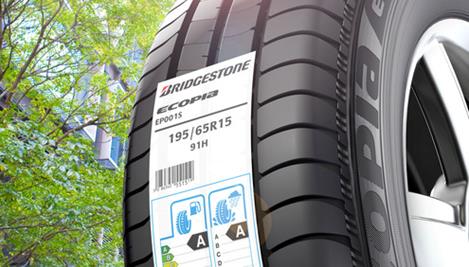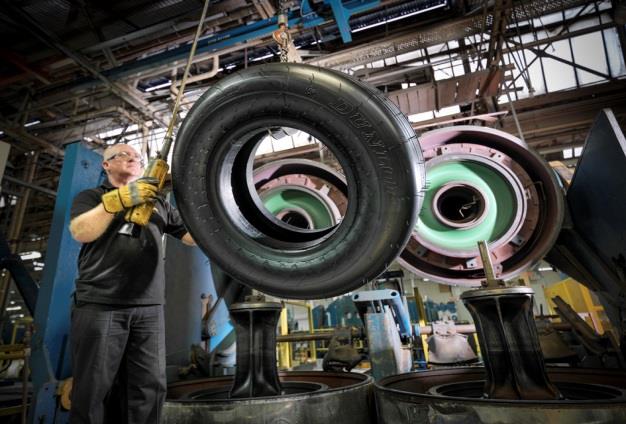Improving the Safety and Performance of Commercial Tyres and other Rubber Products
Submitting Institution
Queen Mary, University of LondonUnit of Assessment
Electrical and Electronic Engineering, Metallurgy and MaterialsSummary Impact Type
TechnologicalResearch Subject Area(s)
Engineering: Materials Engineering
Summary of the impact
Research into a number of different aspects of rubber has fed into a
series of extremely successful collaborations between Queen Mary and a
large number of industrial partners. This has led to significant economic
impacts, ranging from enhancing the performance of teams in the
multi-billion dollar sport of Formula 1 Racing, to helping develop new UK
designed and manufactured radial tyres for large civil aircraft. Rubber
research has been undertaken continuously at QMUL for over five decades.
Prof. James Busfield has led the activity since 1994, working with more
than 30 major industrial collaborators, including Bridgestone, Dunlop, Red
Bull Racing F1 and TARRC, who have applied our research and employed our
researchers to achieve commercial and competitive advantage.
Underpinning research
Prof. James Busfield has led a group of researchers who have each
explored different aspects of rubber performance, much of it funded
through industry-sponsored projects.
The largest sponsor over the last 20 years has been Bridgestone (the
largest rubber product manufacturer in the world with some 140,000
employees). Bridgestone fully funded 4 researchers and financially
supported several others who were working on projects that have made a
difference to the performance of Bridgestone's tyres. For example:
- Dr. Akutagawa (1993-1995) worked on understanding how various
different fillers and extender oils impact the viscoelastic energy
dissipation in tyre compounds, with the overall aim of reducing the
rolling resistance of tyres and hence improving the fuel economy of
vehicles.
- Dr. Tsunoda (1999-2001) worked extensively on understanding the tear
behaviour of rubber [1] to improve the strength, abrasion and fatigue
properties of tyre or hose products.
- Dr. Yamaguchi (2000-2002) examined changes to filler structure under
strain in an elastomer using both mechanical and novel electrical
resistivity measurements [2], aiming to simultaneously improve friction
properties in tyres and reduce rolling resistance.
In addition several other researchers at QMUL, all supervised by
Busfield, have undertaken projects that aim to understand the fundamental
issues of increasing friction in a tyre (to enhance safety in a car tyre
or to reduce lap times in a racing car) whilst reducing rolling resistance
and improving fatigue and abrasion resistance. The various programmes have
sought to examine the fundamentals of friction modelling
(Stratford-Devalba, in post; Gabriel, 2010), abrasion [5] (Wu, in post;
Liang, 2007), fatigue failure [4] (Baumard, in post; Papadopoulos, 2006;
Tsunoda, 2001; Ratsimba, 2000), viscoelastic energy dissipation [3]
(Tunnicliffe, in post; Suphadon, 2010; Deeprasertkul, 2000; Akutagawa,
1995) and polymer filler interactions that relate to all the above (Lowe,
2012; Jha, 2009; Hon, 2005; Yamaguchi, 2002). This predictive work to
examine each of these features has been widely adopted in the industry by
Bridgestone and their competitors and it has also allowed us to work with
a wide range of different partners in related areas. This includes Formula
1 teams such as Red Bull F1 for whom we developed a realistic friction
model (Gabriel, 2009) so that they could better understand and model the
frictional effects in F1 tyres as well as SuperAguri F1 (Liang, 2007) for
whom we modelled, using realistic finite element tyre models, the detailed
contact patch geometry between the tyre and the race track for a wide
range of suspension set ups for every position around a race track and
used throughout the F1 calendar.
References to the research
1. Tsunoda, K; Busfield, JJC; Davies, CKL, Thomas, AG `Effect of
materials variables on the tear behaviour of a non-crystallising
elastomer', J. Mater. Sci. (2000) 35(20): 5187-5198.
2. Yamaguchi, K; Busfield, JJC; Thomas, AG `Electrical and mechanical
behavior of filled elastomers. I. The effect of strain', J. Polymer Sci.
Part B. (2003) 41(17): 2079-2089.
3. Busfield, JJC; Deeprasertkul, C; Thomas, AG `The effect of liquids on
the dynamic properties of carbon black filled natural rubber as a function
of pre-strain' Polymer, (2000) 41(26): 9219-9225.
4. Busfield, JJC; Jha, V; Liang, H; Papadopoulos, IC and Thomas, AG,
`Prediction of fatigue crack growth using finite element analysis
techniques applied to three-dimensional elastomeric components', Plastics
Rubber and Composites, (2005) 34(8): 349-356.
5. Liang, H; Fukahori, Y; Thomas, AG; Busfield, JJC `Rubber abrasion at
steady state', Wear (2009) 266(1-2): 288-296.
6. Jha, V; Hon, AA; Thomas, AG; Busfield, JJC `Modeling of the effect of
rigid fillers on the stiffness of rubbers', J. Appl. Polymer Sci. (2008)
107(4): 2572-2577.
Funding: This work has attracted £475k of industrial funding since
2008
Details of the impact
The work carried out in Queen Mary's Rubber Research Group has informed
the development of automotive engineering processes, leading to direct
economic impacts for a number of manufacturing companies.
The collaboration between Red Bull F1 and QMUL allowed tyre models to be
made as building block components of a state-of-the-art vehicle simulator,
which included for the first time an accurate tyre model. A former Vehicle
Dynamics Engineer at RedBull F1, who is currently the Tyre Team Leader at
Caterham F1, sponsored a research project whilst at Red Bull F1 that
involved QMUL developing a realistic friction model commented "The model
is still used and has clearly contributed to Red Bull's world championship
successes in F1". He went on to say "A particular benefit of our
collaboration with Queen Mary was the access we gained to their other
research activities. Specifically, Queen Mary has been at the forefront of
research into tyre `graining' [5]. This is an especially difficult problem
to analyse, and Queen Mary's work in this area has given great insight. I
have several papers published by Queen Mary, on subjects such as rubber
crack growth [1], rubber abrasion [5], rubber friction, and the rubber to
surface interface. I regularly refer to these, and use them in my current
role within the Caterham F1 team".
Ken Yamaguchi of Bridgestone has commented that: "The greatest
contribution [from Queen Mary] has been in helping us understand how to
develop lower rolling resistance tyres [3] to reduce fuel consumption. In
particular the detailed microstructural and micromechanics models [2,6]
have provided a significant stimulus which has resulted in us undertaking
extensive work in house using a similar approach to the one at QMUL of
adopting a computational model to help design rubber compounds at the
nano-scale". Through this approach Bridgestone became the first tyre
manufacturer to gain the new EU A/A rating for their Ecopia
EP tyres in October 2012, with top A grades on both fuel efficiency
and wet grip. By switching to Bridgestone Ecopia tyres the average
European car can save up to 70 litres of fuel per year (9,000 miles/year)
which will reduce CO2 emissions by 160 kg. Or in other words if all new
cars registered in Europe (15 million) ran on Ecopia EP tyres this would
save up to 1 billion litres of fuel and reduce total CO2 emissions by 2,3
million tons per year (equivalent to 0.5% annual UK CO2 emissions).
The Materials Development and Testing Manager of Dunlop
Aircraft Tyres has commented that the project collaborating with
QMUL has helped them make significant progress in their efforts to develop
radial tyres for civil and military aircraft and bring them to market. He
comments that, "Adopting the fracture mechanics characterisation based
upon earlier work done at QMUL [4] and coupled with finite element
modelling, they were able to resolve many problems and build tyres capable
of meeting the stringent qualification testing required prior to
installation on aircraft. These efforts have resulted in our radial tyres
for Embraer 190 and ATR 42 aircraft being widely used". It is anticipated
that tyres for the Embraer 170, ATR 72, JSF and Airbus A320 will be
installed on aircraft in the near future creating a solid platform for
further development on radial tyres for a range of other aircraft in the
coming years. He adds, "This has helped us generate significant new
business for the UK in the design and manufacture of radial aircraft
tyres".

 Rubber research at QMUL has assisted in the development of Bridgestone's
Ecopia tyre (left) that combines A rated wet grip with A rated
fuel economy, and Dunlop's
radial aircraft tyre (right).
Rubber research at QMUL has assisted in the development of Bridgestone's
Ecopia tyre (left) that combines A rated wet grip with A rated
fuel economy, and Dunlop's
radial aircraft tyre (right).
The Head of the Engineering Design Group at TARRC, commented that: "Our
collaborations with QMUL have allowed TARRC to make much more effective
use of finite element analysis techniques to predict the behaviour of
components in service. This knowledge allows us to design rubber
components ranging from vibration mounts that support large engineering
structures such as the new Penang Bridge in Malaysia, to much smaller
anti-vibration mounts used in automotive applications".
A former chief R&D Engineer at SuperAguri F1 who now works at
Mercedes F1 has commented that the collaboration with QMUL allowed a
detailed understanding of how tyre road interactions are developed in F1
for the first time. This impacted SuperAguri's understanding of how to
optimise the suspension configuration to improve performance. He goes on
to say: "The project was extended at SuperAguri using a Queen Mary PhD
graduate to undertake track side analysis. This type of modelling was
pioneering at the time and is now standard practice amongst most F1
teams". The fact that a QMUL graduate was employed by SuperAguri F1 as a
result of successful research collaboration leads to the significant
secondary impact described in this case. Many QMUL researchers have taken
up roles at Queen Mary's industrial partners, facilitating knowledge
transfer and benefiting the UK economy.
Drs Keizo Akutagawa, Katsuhiko Tsunoda and Ken Yamaguchi joined
Bridgestone after completing their research project at QMUL. By 2010 all
three had been promoted to the highest senior research position (Research
Fellow), of which there are fewer than 20 within the company, which has
140,0000 employees. All three have gone on and continue to develop the
techniques that were initiated as part of their studies at QMUL and have
embedded their use in materials development processes that are used at
Bridgestone.
TARRC also employs two former Rubber Research Group researchers, Julia
Gough (2000) and David Lowe (2012) and is in contact regularly with two
further former researchers Azura Rashid (2003) and Asri Ahmad (2002) who
work with or for their parent company (RRIM in Malaysia).
Sources to corroborate the impact
- Dr. Ken Yamaguchi — Fellow at Bridgestone Corporation.
- Dr. Keizo Akutagawa — Fellow at Bridgestone Corporation.
- Concept Stress Engineer at Mercedes-Benz Grand Prix Ltd. (formerly at
SuperAguri F1).
- Tyre Team Leader at Caterham F1 (formerly at RedBull F1).
- Head of Engineering Design at TARRC.Materials.
- Development and Testing Manager at Dunlop Aircraft Tyres.